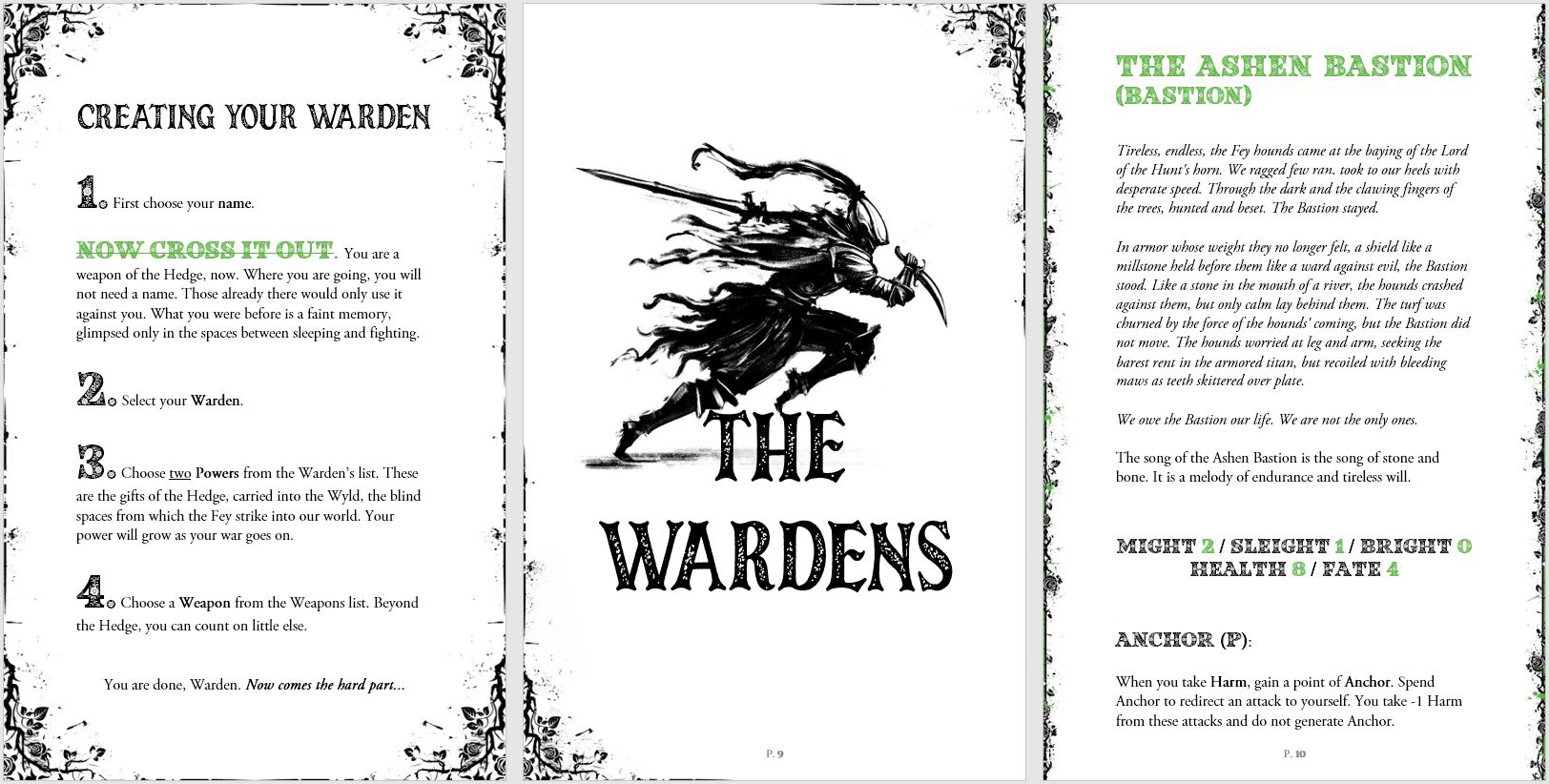HEDGE is combat-heavy fantasy RPG set in a post-Fey apocalypse world. Its system is built on the Illuminated by LUMEN framework, and that means MMORPG- and team shooter-like gameplay: character roles, loot drops, and hordes of enemies to raze down.
You play as Wardens: undying, supernatural warriors powered by the entity known as The Hedge to fight against the Fey who have taken over the world whilst desperately holding on to your fading humanity. The flavour text for the world and characters are short yet rich, vivid, and striking, a sumptuous appetiser that complements the juicy main course: its simple and straightforward rules of engagement.
White-Knuckled Action
HEDGE is about combat and little else (well, there is an expansion with rules for building survivor settlements, but we didn’t look into that in our Systems Check session). It’s blow-by-blow, turn-by-turn. Wardens go first, then enemies retaliate.
A combat-heavy fantasy RPG will inevitably draw comparisons to Dungeons & Dragons and Pathfinder, the giants in the genre. Those games are known for having “crunchy” rules in addition to long lists of classes, weapons, armour, spells, and other customisation options.
HEDGE does not have any of that. Each Warden playbook corresponds to an archetypal role found within the video games HEDGE was inspired by (tank, damage-dealer, or support) and each has a set number of powers reinforcing that role. Weapons can take any form but have 2 attributes only. All in all, there is little build variety, and I suspect this serves to make building a synergetic party easier. The playbooks, powers, and weapon attributes are pretty balanced except in a couple of places, where certain options look glaringly stronger than others that it becomes the no-brainer choice.
On each of their turns, Wardens can do 3 things: move, activate a power, make a weapon attack or interact with the environment (in no particular order). Weapon attacks must be rolled for with d6s — there is a ⅔ or better chance of hitting any enemy — but powers always work no matter what. Wardens also have a passive power and a “Fade” power which activates when they are knocked down to 0 HP, supporting their teammates from beyond the grave (though not for long — fallen Wardens always get revived eventually).

As for enemies, there are 4 classes of foes, ranging from squishies to boss monsters. Squishies do little damage and are usually killed in one hit, boss monsters have a big HP bar and deadlier, more varied moves, etc. (If you play video games, you know this goes.) Enemies do not need to roll for attacks, they can always deal damage, and the vague descriptions of their unique abilities can be interpreted however the GM wishes. Killing enemies begets Wardens health points, “Fate” points to fuel their powers, or — very occasionally — “Grafts”. Grafts are rare loot from fallen Fey that can, as the name suggests, be grafted onto a Warden’s body to grant them one of that Fey’s abilities at the expense of their humanity.
This overall lack of rolling is what gives the game its fast and punchy combat, in stark contrast to combat in D&D and Pathfinder which can often get bogged down in complicated rules and waiting for roll results. Characters feel like absolute badasses in a power fantasy as they mow down foe after foe, standing against hordes of hostiles like rocks breaking the waves. One adjustment I made to the rules for even faster momentum was to roll for loot drops immediately after an enemy is killed and have the loot automatically go to the Warden who got the final blow, unless the player states otherwise.
That all worked very well in the session. What didn’t work so well was how HEDGE does maps and distance. Where D&D and Pathfinder use grids with discrete distance measurements for battle maps, HEDGE uses range bands and vague distance markers like “near” and “far”, which our table found to be vexing and confusing at times, even slowing down the momentum of combat as we puzzle over how things would work. One player pointed out that range bands on a map ought to be combined with character tokens also having their individual range bands, but at that point, why not just use a regular grid? This, along with a lack of rules for doing extra movement on a turn, forced me to play fast and loose with the written rules and hand-wave stuff on the fly.

Final Thoughts
HEDGE feels like the light popcorn alternative to crunchier games in the same niche. A GM doesn’t need to prep much — just grab a random combination of enemies from the book and throw them at the players. Not having to deal with complex statblocks and lair actions and whatnot can be freeing.
However, HEDGE‘s lack of polish is what keeps it from being truly great. There are some vague and confusing terminologies in the book — the absence of definitions for “combat”, “battle”, and “wave” misled me to believe that fallen Wardens revive only after the fighting has stopped instead of in between waves of enemies (oops); it desperately needs a glossary and a table of contents. And clarification on how range bands work, and how extra movement can be ruled, and others…
HEDGE brings fresh ideas to the table that are a welcome change of pace from crunchier fantasy combat games. Does it threaten to rival or unseat the more refined and established titles in the genre? No, but that’s no reason to pass on it.
Buy HEDGE here.
Cover art by Artem Demura from ArtStation.
Anyone is welcome to join a Systems Check session, and all sessions are beginner-friendly. Please join our Discord server to play and reach out to the GM when you sign up for a session.
You can also find us on these social platforms: